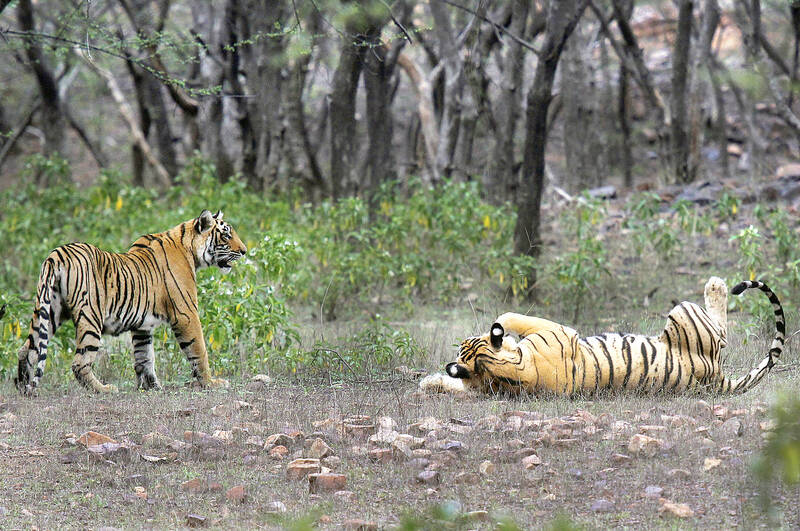Just hours away from several of India’s major tiger reserves in India’s southern city of Mysuru, Indian Prime Minister Narendra Modi was yesterday to announce the recovery of the country’s tiger population since its flagship conservation program began 50 years ago.
However, protesters tell their own stories of how they have been displaced by such wildlife conservation projects over the past half-century.
Project Tiger began in 1973 after a census of the big cats found that India’s tigers were going extinct through habitat loss, unregulated sport hunting, increased poaching and retaliatory killing. Laws attempted to address those issues, but the conservation model centered around creating protected reserves where ecosystems can function undisturbed by people.

Photo: AP
Several indigenous groups said the conservation strategies, deeply influenced by US environmentalism, meant uprooting numerous communities that had lived in the forests for millennia.
Members of several Adivasi groups — as indigenous people are known in the country — set up the Nagarahole Adivasi Forest Rights Establishment Committee to protest evictions from their ancestral lands and seek a voice in how the forests are managed.
“Nagarahole was one of the first forests to be brought under Project Tiger and our parents and grandparents were probably among the first to be forced out of the forests in the name of conservation,” said J.A. Shivu, 27, who belongs to the Jenu Kuruba tribe. “We have lost all rights to visit our lands, temples or even collect honey from the forests. How can we continue living like this?”
The fewer than 40,000 Jenu Kuruba people are one of the 75 tribal groups that the Indian government classifies as particularly vulnerable.
Jenu, which means “honey” in the southern Indian Kannada language, is the tribe’s primary source of livelihood, as they collect it from beehives in the forests to sell. Adivasi communities such as the Jenu Kurubas are among the poorest in India.
Experts said conservation policies that attempted to protect a pristine wilderness were influenced by prejudices against local communities.
The Indian Ministry of Tribal Affairs has repeatedly said it is working on Adivasi rights.
Only about 1 percent of the more than 100 million Adivasis in India have been granted any rights over forest lands despite the enactment of the Forest Rights Act, passed in 2006, that aimed to “undo the historical injustice” for forest communities.
Their indigenous lands are also being squeezed by climate change, with more frequent forest fires spurred by extreme heat and unpredictable rainfall.
India’s tiger numbers, meanwhile, are ticking upwards: The country’s 2,967 tigers account for more than 75 percent of the world’s wild tiger population. India has more tigers than its protected spaces can hold, with the cats living at the edge of cities and in sugarcane fields.
Tigers have disappeared in Bali and Java, Indonesia, and China’s tigers are likely extinct in the wild. The Sunda Island tiger, another subspecies, is only found in Sumatra, Indonesia. India’s project to safeguard them has been praised as a success by many.
“Project Tiger hardly has a parallel in the world since a scheme of this scale and magnitude has not been so successful elsewhere,” Project Tiger lead official S.P. Yadav said.
However, critics said the social costs of fortress conservation — in which forest departments protect wildlife and prevent local communities from entering forest regions — is high.
The conservation model is outdated, Ashoka Trust for Research in Ecology and the Environment researcher Sharachchandra Lele said.
“There are already successful examples of forests managed by local communities in collaboration with government officials, and tiger numbers have actually increased even while people have benefited in these regions,” he said.
Wildlife Conservation Society in India director Vidya Athreya, who has been studying the interactions between large cats and humans for the past two decades, agreed.
“Traditionally we always put wildlife over people,” Athreya said, adding that engaging with communities is the way forward for protecting wildlife in India.
Shivu, from the Jenu Kuruba tribe, said he wants to go back to a life where indigenous communities and tigers lived together.
“We consider them gods and as the custodians of these forests,” he said.

Kehinde Sanni spends his days smoothing out dents and repainting scratched bumpers in a modest autobody shop in Lagos. He has never left Nigeria, yet he speaks glowingly of Burkina Faso military leader Ibrahim Traore. “Nigeria needs someone like Ibrahim Traore of Burkina Faso. He is doing well for his country,” Sanni said. His admiration is shaped by a steady stream of viral videos, memes and social media posts — many misleading or outright false — portraying Traore as a fearless reformer who defied Western powers and reclaimed his country’s dignity. The Burkinabe strongman swept into power following a coup in September 2022

‘FRAGMENTING’: British politics have for a long time been dominated by the Labor Party and the Tories, but polls suggest that Reform now poses a significant challenge Hard-right upstarts Reform UK snatched a parliamentary seat from British Prime Minister Keir Starmer’s Labor Party yesterday in local elections that dealt a blow to the UK’s two establishment parties. Reform, led by anti-immigrant firebrand Nigel Farage, won the by-election in Runcorn and Helsby in northwest England by just six votes, as it picked up gains in other localities, including one mayoralty. The group’s strong showing continues momentum it built up at last year’s general election and appears to confirm a trend that the UK is entering an era of multi-party politics. “For the movement, for the party it’s a very, very big

A new online voting system aimed at boosting turnout among the Philippines’ millions of overseas workers ahead of Monday’s mid-term elections has been marked by confusion and fears of disenfranchisement. Thousands of overseas Filipino workers have already cast their ballots in the race dominated by a bitter feud between President Ferdinand Marcos Jr and his impeached vice president, Sara Duterte. While official turnout figures are not yet publicly available, data from the Philippine Commission on Elections (COMELEC) showed that at least 134,000 of the 1.22 million registered overseas voters have signed up for the new online system, which opened on April 13. However,

ENTERTAINMENT: Rio officials have a history of organizing massive concerts on Copacabana Beach, with Madonna’s show drawing about 1.6 million fans last year Lady Gaga on Saturday night gave a free concert in front of 2 million fans who poured onto Copacabana Beach in Rio de Janeiro for the biggest show of her career. “Tonight, we’re making history... Thank you for making history with me,” Lady Gaga told a screaming crowd. The Mother Monster, as she is known, started the show at about 10:10pm local time with her 2011 song Bloody Mary. Cries of joy rose from the tightly packed fans who sang and danced shoulder-to-shoulder on the vast stretch of sand. Concert organizers said 2.1 million people attended the show. Lady Gaga